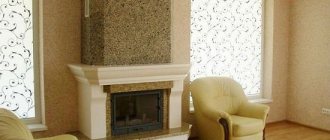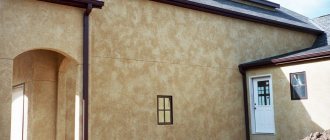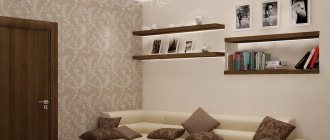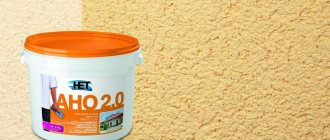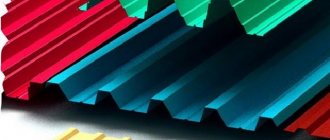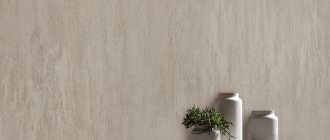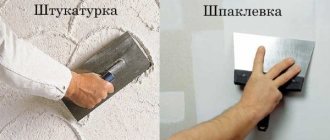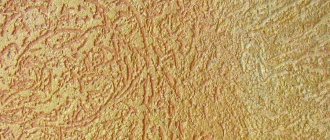With the development of technology, new materials for finishing work are being developed. One of the remarkable innovations of the last century was polymer plaster. This is a high-quality elastic material that makes it possible to obtain results that other types of mixtures (for example, mineral) cannot provide. And it's all about polymers.
Types of polymer plaster by area of application
The word “polymer” in everyday life is strongly associated with the concept of “plastic”. How can you make a “plastic” wall covering with your own hands? Yes, exactly the same way as classic plastering work is done. The difference is that instead of mineral (inorganic) binders, known for a long time, dispersions of resins (organic substances - epoxy resin, polyurethane, acrylic) are used in polymer plaster solutions. Depending on the type of base solvent, polymer plaster compositions are intended for use in various conditions. Thus, compositions, the component of which is a resin based on an aqueous dispersion, can be intended for indoor or outdoor plastering work or are universal. Compositions based on resin in other solvents are intended for facade finishing.
Synthetic (polymer) plasters are intended for finishing.
According to their application for plastering structural elements, they are:
- butadiene-styrene, styrene-acrylic, polyurethane bases - for basement finishing;
- styrene-acrylic, acrylic binders - for walls;
- siloxane - for mineral wool coating;
- acrylic - for covering polystyrene foam insulation.
Walls
0 votes
+
Vote for!
—
Vote against!
Decorative plaster is a solution used for finishing walls outside public buildings and private houses, as well as inside apartments, offices and other premises. Its main purpose is to improve the aesthetic and decorative qualities of the surface. In this article we will consider all types of decorative plaster for walls.
The word “plaster” is of Italian origin and is literally translated as “plaster” or “alabaster”. The composition of the plaster mixture for decoration has common components with conventional plaster - sand, lime, cement, but its main difference is the addition of various granules - dry bulk substances in the form of small granules, for example, stone chips, wood fibers, etc.
- Decorative plasters can be sold ready-made, that is, previously diluted with water or a special solvent, such mixtures can be immediately used for work. Dry components can also be supplied, which must be diluted according to the instructions before application.
- Depending on the final result and the design idea, you can independently add various fillers to the decorative plaster: small pieces of mica, shells or small pebbles, which, after the layer of plaster has hardened, will look organic on the wall. In addition, in this way it is possible to achieve the effect of additional surface volume.
Types of decorative plaster for walls
The surface can be decorated in various ways, for example, simple plaster can decorate a wall, giving it a perfectly smooth structure. Of course, thanks to the special composition, it became possible to obtain a relief effect, achieve a glossy surface or imitate any natural materials without much effort.
Decorative plaster is distinguished according to several principles. For example, by type of filler it can be:
- textured;
- structural;
- Venetian
Textured and structural appearance form a rough surface and are usually called relief plasters, while Venetian plasters form a perfectly smooth surface, so they are classified as a smooth type of plasters.
All of the listed types are made on the basis of environmentally friendly substances, due to which they are considered safe, reliable and durable materials.
There are several types of plaster based on the binder used.
- Acrylic. The binder is a high molecular weight polymer (acrylic resin), which ensures good elasticity of the applied layer. It may contain organic and inorganic pigments, thanks to which the composition acquires different colors. Acrylic decorative plaster is sold as a ready-made mixture. The disadvantage of this type of coating is low vapor permeability, so the material is limited in use. Plaster is also susceptible to UV rays, and over time the coating may begin to crack. Acrylic resin in the composition allows you to paint the mixture in any desired color using pigment pastes.
- Mineral. The binder is cement. It has a relatively low price and is most often produced in the form of a dry mixture, which must be diluted with water before use. An excellent option for decorative plaster for bathroom walls and for exterior use. In humid weather, add a little less water to the solution. It is considered the most environmentally friendly decorative material. Over time, such a coating only becomes stronger, has good resistance to UV rays, but is afraid of mechanical damage, in addition, it is not advisable to wash it with devices using high pressure. The standard color of such plaster is considered to be light.
- Silicone. The binding component is synthetic resins. It is used for exterior finishing and interior work; it is flexible and easy to apply. They are resistant to UV rays and do not attract dust and foreign odors. When applied, it forms a moisture-repellent layer, due to which silicone decorative plaster is used for cladding external walls in areas of high humidity. Available in the form of a ready-made mixture in various colors.
- Silicate. The binder is liquid glass (alkaline potassium carbonate, quartz sand and potassium hydroxide). It is distinguished by the high strength of the applied layer, resistance to mold and rot, as well as the ability to repel water. The mixture has impregnating, adhesive and astringent qualities. It can be used on almost any surface and has excellent fire resistance and vapor permeability. Supplied as a ready-mix in various color shades. One of the most reliable plasters, its service life can reach 50 years or more.
Silicate and silicone plasters are most often used for finishing facades and during construction in humid climates.
Textured plaster
- This is a plaster with a coarse, highly viscous structure. The filler is flax fibers, wood, mica, mineral chips (granite, marble) or small pebbles. It is used for decorating brick, concrete, plastered, and wooden surfaces. Excellent for exterior decoration and interior work.
- Thanks to special particles in the composition, textured plaster hides large defects and most surface irregularities. To apply it, practically no preliminary preparation of the walls is required; it is enough to dry and clean them; if there are peeling coatings, they should be removed, and then an adhesive composition or a special “concrete contact” solution should be applied, this is necessary for reliable adhesion of the plaster to the wall.
- The applied layer is highly hard, waterproof and forms an air-permeable coating. The resulting surface can be an imitation of natural stone, genuine leather, wood or fabric. Among the types of decorative plaster, textured is the most common; in addition, it has a relatively low price.
- The plaster is supplied for sale in various containers, weighing 9, 18, and 50 kg, dry and ready for use. It can be tinted in any color when applied, or painted after drying. Average consumption up to 2 kg per 1 m2. The larger the filler, the more composition is required to apply one layer. It is not recommended to use plaster for external work during rains or humid weather, and at temperatures up to + 7 degrees.
- You can apply textured plaster without using highly specialized tools, and there is no need to involve professionals; even when decorating the walls yourself, you get many design options.
Subtypes of textured plaster
- Lamb - plaster has stone grains of various sizes, is applied to mineral bases, the surface is rough and evenly grained.
- Fur coat - the surface after application is rough, in the form of a slight “hairiness”, the main component of this mixture is cement.
- Bark beetle is a composite plaster with a fine stone filler; when applied, it forms a grooved texture reminiscent of the surface of corroded wood.
The peculiarity of textured plaster is that the surface relief appears immediately after application.
Structural plaster
- A material with a thin-layer structure, made on an acrylic or silicate base. Marble chips or quartz elements are used as a structure-forming substance. Outwardly it looks like a granular heterogeneous mass. It is used for decorating walls indoors and finishing facades.
- It may be fine-grained and look like an almost even layer when applied, or medium-grained; after such plaster dries, a peculiar relief appears. Has good adhesion to most mineral surfaces, plasterboard and chipboard.
- Structural plaster forms a layer with excellent breathability, resistant to moisture and atmospheric conditions. Available in 9, 18 and 50 kg packages. Supplied as a ready-made mixture, adding coloring pigments to the composition is not allowed. Apply with a trowel to a dry, clean surface, pre-treated with a deep penetration primer. The consumption rate when applied in one layer is 3 kg per m2.
- It is not recommended to use in damp rooms or during rain during outdoor work; the air temperature should be above +7 degrees. Plaster can be applied using various methods and tools: a smooth spatula, a roller or a sprayer. So, to obtain the effect of waves, coarse-grained plaster is used, which is applied in a circular motion using a spatula.
- Very often, structural plaster is used for finishing walls in corridors and bathrooms, as well as for finishing facades, fences and gates. For interior work, it is recommended to use water-based, quick-drying and odorless material. The resulting surface is quite impact-resistant and resistant to mechanical damage. Wet cleaning of the plastered wall is allowed.
Venetian plaster
- This phrase appeared as a result of the literal translation of the phrase “stucco veneziano”. It is a decorative multilayer coating. This plaster mixture is made with the addition of marble chips and slaked lime. It has a fairly homogeneous structure. It became widespread back in ancient Rome, when when working with marble, a lot of dust and small particles remained, which began to be used as a material for cladding.
- Visually, the finished layer resembles the surface of natural marble or onyx. Proper finishing with Venetian plaster requires special skill. It should be applied with a flexible rubber spatula, in thin strokes, in several layers (5-6), each of which requires thorough drying. The material is quite expensive, but the resulting effect fully justifies its price. Most often, Venetian plaster is used in rooms decorated in antique or classical style, as well as in the Baroque style.
- Thanks to various application methods, you can achieve a matte or glossy surface. Plaster is intended for indoor use only. The mixture can be tinted. Available in containers of 8 and 16 kg. The surface to be decorated must be clean, level and dry. Before facing the walls, it is recommended to pre-reinforce them, and then putty and prime them. If the technology is violated, cracks may form on the decorative plaster, which are very difficult to get rid of.
- In addition to the stone surface, Venetian plaster can imitate precious metals, due to special coloring with special pigments. Using this type of finishing indoors, you can achieve the effect of increasing space due to the refraction of light. This coating often acts as a basis for complex panels and frescoes.
Specific types of decorative plaster
- Colored plaster - made on the basis of acrylic and marble chips. It has high adhesion to mineral surfaces, water resistance and sufficient hardness. The color range is represented by fifteen shades. Apply to a dry, clean surface in one layer. To prevent noticeable joints, the mixture must be brought to the corner. Equally suitable for both external and internal work.
- Roller plaster - contains filler of natural origin of various fractions from 1 mm to 2.5 mm. When applied, a texture with small channels-indentations is formed. It is used for decorating facades and decorating walls inside office and residential premises. Tinting or surface painting is allowed. It is applied to the surface with a wide spatula and then rubbed with a trowel in circular, cross-shaped, vertical or horizontal movements.
- Latex plastic - allows you to create a smooth coating with a slight gloss, imitating the texture of smooth stone or marble, as well as various relief surfaces. The material is resistant to cracking and has high moisture resistance, making the plastered surface easy to clean. The mixture can be tinted in various colors, but in order to achieve the effect of the structure of natural stone, the colors should not be thoroughly mixed. The mixture is applied only to smooth walls, previously plastered and treated with a deep penetration primer.
- “Wet silk” - a coating reminiscent of the surface of a fabric, contains pearlescent particles, the iridescence of which imitates the iridescence of flowing silk. Tinting in any color is allowed; initially several color variations are available: white, gold, garnet, silver and bronze. The resulting surface is highly moisture resistant and tolerates wet cleaning. An excellent option for decorative plaster for kitchen walls.
- “Sea Breeze” – the coating has a translucent structure, with a slight pearlescent tint. Fine-grained sand is added to the composition. It can be tinted and is available in several basic colors: gold, white, garnet, bronze and chameleon. Used for interior decoration.
Advantages of decorative plaster
Decorative coating based on plaster has won the love of many designers, thanks to the special properties and qualities that distinguish it from other materials for interior decoration.
- Able to hide unevenness and defects of the surface being decorated;
- can be applied to most known materials (brick, stone, concrete, wood, drywall and many other coatings);
- does not absorb odors;
- has high sound-absorbing properties;
- has a unique and inimitable design;
- application does not require special surface preparation;
- is characterized by high levels of resistance to any atmospheric phenomena;
- The resulting coating has breathable properties;
- forms a moisture- and frost-resistant layer;
- thanks to its special plasticity, it is possible to process structures of any complexity, as well as create all kinds of patterns and designs;
- forms an environmentally friendly, practical and durable coating that is resistant to mechanical stress;
Decorative plaster of walls in an apartment
To obtain a high-quality decorative coating, the solution should be applied using tools that are free from defects, damage, chips, cracks or nicks. Each type of plaster mixture requires its own finishing methods and techniques to give the surface expressiveness and special artistic properties.
Venetian plaster
- Venetian plaster, to develop the required pattern, requires multi-layer application. The work is carried out using stainless steel painting tools of various widths (trowel, spatula). The main layer is applied with the widest tool, leaving gaps on the surface. The strokes are made wide and asymmetrical. All subsequent layers must cover the gaps of the previous application. To make it more expressive, each layer can have its own color shade.
- The applied layers are dried one by one, each of them is leveled and additionally ground with a smooth steel tool. This method is called ironing, due to which the surface acquires a glossy appearance. If additional shine is required, the plaster can be coated with a special varnish or wax. Due to translucent layers, the effect of depth and volume is achieved.
Relief decorative plaster
- Finishing with relief decorative plaster occurs a little differently. In this case, no special treatment of the walls is required, as for applying smooth plasters. It is enough to remove old finishing materials (painting, wallpaper, whitewash), clean and dry the surface.
- After which the walls are treated with a primer. This procedure is carried out about a day before finishing with relief plaster. It is best if the primer composition has antibacterial properties that prevent the development of fungi and mold.
- The plaster mixture is applied to the primed surface with a wide soft spatula. Immediately after this, it is necessary to give the layer a relief. This should be done very quickly, as the composition sets instantly.
- You can obtain the desired pattern on textured plaster using tools such as spatulas, sponges, rollers, smoothers or stencils. For example, when using a rubber roller, you should wet it in water before each application of texture. The work is carried out immediately over the entire area of the wall (from corner to corner), otherwise noticeable seams cannot be avoided.
Structural plaster
- Structural plaster is applied with a stainless steel trowel. The layer should be slightly larger than the grain size. The treated surface is kept for 2-3 minutes, and then smoothed in a circle with a plastic trowel.
- This method ensures uniform distribution of the granules contained in the composition over the treated surface. Excess mixture is regularly removed from the trowel with a small spatula.
- Structural plaster, like textured plaster, forms joints during application, so work is carried out from corner to corner at a time.
Advice: if there is a need to paint relief plaster, then you should do this 10-14 days after application.
Basic coating care
The decorative coating formed by relief or smooth plaster is quite durable and resistant to mechanical damage and atmospheric conditions, so no special care is required in the first year after application.
- This material does not absorb odors and does not attract dust, and also contains water-repellent substances, due to which the surface, if necessary, can be easily washed with ordinary detergents without chemical fillers. When cleaning, it is better to use a soft cloth or sponge, avoiding hard brushes, metal scrapers, pumice stones or plastic.
- To increase the service life of the plaster coating, special waxes or glazing compounds are applied over the dried decorative layer. Artificial or beeswax helps increase the waterproofing of the surface, and when applied to Venetian plaster, it provides additional shine.
- The wax composition is supplied ready-made. With its help, you can emphasize the smallest details and the depth of the relief of applied decorating mixtures, while increasing their resistance to mechanical stress, and providing additional protection from dust, dirt and moisture. Protective wax is available in two versions: with a mother-of-pearl effect, having a silver-white tint, and in a translucent form, with a yellowish tint.
- This product must be applied in a double layer using a spatula, sponge or brush, and after drying, polished with a soft cloth. Wax surfaces cannot be cleaned with solvents; only a soap solution or clean water is allowed.
- Glazing is an almost transparent, light coating designed to give an additional shade; in addition, it adds volume and emphasizes the contours of the relief. It can have several shades that imitate gold-plated, silver or bronze surfaces, as well as simply white, transparent or iridescent color. The product is applied with a brush, sponge, rubber spatula or special mitten. Can be washed with detergents or soapy water.
Protective compounds are used for all types of plaster used for finishing walls indoors and outdoors. Thanks to such means, it will last longer, will not crumble or crumble, which means its maintenance will be minimal.
How to renew a decorative plaster coating
If you need to remove decorative coating from a wall, you can use several methods:
- repainting in a different color - done when it is necessary to change the color scheme;
- removal to the concrete base - when it is necessary to apply another version of plaster;
- puttying over the layer to a smooth, even wall - such a surface can be finished with a light decorative material, for example, wallpaper.
Decorative plaster for walls video
When choosing decorative plaster, it is impossible to say which type is better or worse. It all depends on everyone’s personal preference and the requirements put forward for the finished result, as well as the availability of a certain budget, because the price of decorative plaster for walls sometimes differs by an order of magnitude. It is quite easy to apply one mixture, for example, textured and structural, and you can do it yourself, but applying Venetian plaster will require the involvement of specialists. You must remember this when purchasing decorative coating.
Reasons for the popularity of the material
Experience in the use of polymer compositions has revealed many advantages that have become the reason for their popularity.
The main advantages of polymer plasters:
- high elasticity, especially pronounced when using silicone coatings;
- resistance to abrasion and impact mechanical influences (old polymer coatings are not so easy to remove, some have to be cut down);
- frost resistance;
- water resistance, waterproof;
- durability (up to 25 years or more);
- high adhesion rates;
- vapor permeability;
- workability;
- rapid strength gain;
- solidity of the plaster coating;
- new effects that are unattainable when using mineral plasters;
- rich palette.
In fairness, the disadvantages should be mentioned:
- require preliminary leveling of the bases;
- the composition is purchased only in finished form;
- the contents of the opened package must be consumed at once (not stored);
- the price of mixtures is higher than conventional mineral ones.
These disadvantages not only do not outweigh the advantages, but are quickly offset by them.
Technical composition of the solution
Polymer cement mortar for concrete consists of certain compositions suitable for decorative finishing. They include:
- Mineral binder product;
- High calcium ash;
- Portland cement;
- Low fired clay;
- Fillers;
- Latex;
- Water.
When choosing other manufacturers, the composition may vary slightly. Compared to conventional cement mortar, such mixtures have a finely porous structure, increased extensibility, resistance to bending and adhesion. If the addition of polymers to cement is done correctly, the mixture is saturated with properties for less shrinkage.
Most polymer additives have an air-entraining function. Therefore, when mixing such a solution, oxygen penetrates into the composition and the polymer-cement solution is saturated with air, becoming more porous than conventional cement mixtures.
Penetrating into the pores of the composition, polymer additives narrow them, which is why a fine-grained structure is achieved. The polymer has a strong astringent; it connects the filler and cement, while strengthening the future stone.
This is interesting: Foamed backing for polyethylene laminate: Types, Design of PE backing
Surface preparation
Wall preparation is a mandatory stage of work that should not be neglected when applying polymer plaster.
The general rules are the same as for mineral plasters:
- the base is inspected;
- remove unusable old plaster coating, as well as wallpaper, paint and varnish;
- brick seams are unstitched;
- shingles are stuffed onto a wooden wall or reinforcement mesh is attached;
- chips, shells, cracks are “treated” with cement mortar;
- oil stains, rust, foci of fungus, microorganisms, and mold are neutralized;
- the surface is dust-free;
- the base is primed;
- After priming, the wall is dried for at least 24 hours.
Advantages and disadvantages
The decorative mixture has a number of advantages:
- masks unevenness, cracks, crevices and other defects;
- allows you to create beautiful, exclusive designs;
- durable and wear-resistant:
- withstands temperature changes, ultraviolet radiation, frost, mechanical stress;
- when dried, it forms a monolith that lasts for many years, more than 10 years;
- does not emit toxic substances, therefore harmless to human health;
- universal - used for both interior and exterior work;
- applied to any surface - concrete, wood, old plaster;
- has a wide range of colors;
- moisture resistant - can be used in damp rooms;
- has soundproofing qualities.
Application technology
Conditions for the plastering process:
- temperature +5 – +30°С;
- humidity – up to 75%;
- no draft;
- protection from sun rays and precipitation.
The method and technique of application correspond to decorative effects. They are described in the relevant sections of the site.
The basic algorithm is as follows:
- Prepare and prime the wall.
- Applying the first base coat. This layer is applied evenly, most often using a trowel.
- Second layer. Using a trowel or spatula, the solution is applied in a uniform layer, the thickness of which is determined by the filler fraction.
- After the applied plaster has dried, it is given the desired effect.
- Finishing (for example, varnishing). This stage is performed only if the technology requires it.
The process of creating the desired effects varies depending on the chosen polymer plaster.
An example of applying polymer acrylic plaster:
Since the mixtures are purchased ready-made, before work you only need to additionally mix the solution with a mixer. Drying time of the coating is 12 – 24 hours.
Combination of decorative plaster with finishing
It is important to combine decorative materials correctly, choosing colors and combining textures:
- Textured plaster looks interesting, complementing the finish with smooth wallpaper.
- To emphasize the features of the loft style, art concrete and the effect of brickwork are used.
- For a classic interior, the ideal combination is smooth, plain plaster with Venetian finishing.
- The ethno-style is in harmony with bark beetle plaster and wooden surfaces of walls, furniture, and ceilings.
- Venetian plaster looks elegant against the background of a plain ceiling covering and parquet.
- The “Marseille wax” texture is best used for baroque, country, and Provence styles. Forging and artistic stucco work effectively with it, enhancing the interior.
- “Sea Breeze” is combined with decorative wallpaper and photo wallpaper.
The use of different finishing methods allows you to zone the room and create visual accents.
Textured decorative plaster harmoniously combines with smooth wallpaper
Manufacturers
Polymer plaster for facades, utility rooms and residential premises is supplied to the market by popular and little-known companies.
The most recognizable brands are Zeresit, Knauf, Weber, Bergauf, Baumit, Decorazza. Since the Russian domestic market is going through the formation stage, it is difficult to analyze. Often foreign companies, opening representative offices, then create branches that produce plaster mixtures in Russia. Decorative compositions are brought from France, Italy, Germany. More often, such products are more expensive than Russian ones.
Polymer plaster has proven itself well in Russian conditions, so there is a high probability that it will become that magic wand that will fantastically transform your home.
